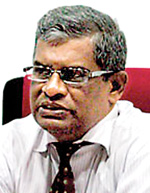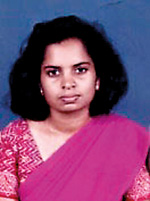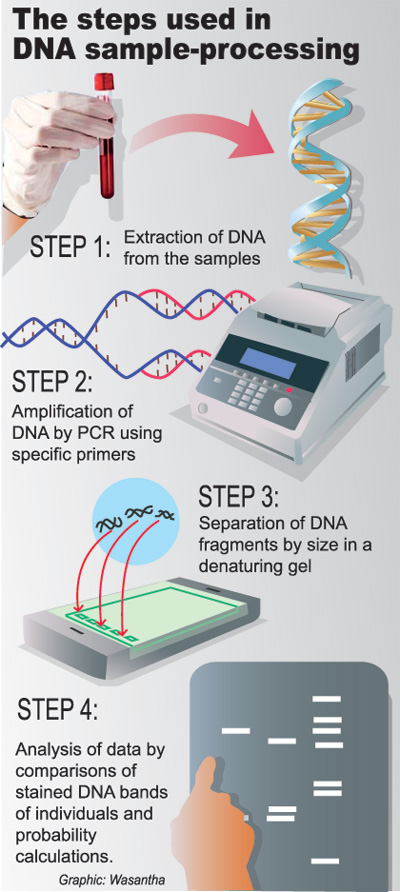Am I the child of my parents?
Who is my father? Who is my mother?
This is the tragic scenario that some people face in life. It can come about due to a child being adopted either within this country or taken abroad after adoption or due to a child being abducted and then found later.

Quality is ensured when DNA testing is done. Pix by M.A. Pushpa Kumara
The state-of-the-art laboratory at the Molecular Medicine Unit (MMU) of the Ragama Faculty of Medicine, University of Kelaniya has been carrying out ‘DNA fingerprinting for human identification’ to help out in such instances.
“We handle paternity cases directed by court,” says the Head of the MMU, Dr. Menaka Hapugoda. The MMU operates under the direction of Prof. W. Abeyewickreme who is responsible for paternity testing and forensic DNA fingerprinting services.
“In the case of private cases, we will carry out DNA fingerprinting only if the child’s best interests are not affected,” Dr. Hapugoda hastens to explain, adding that a committee comprising three senior academics will decide whether a paternity test should be carried out or not.
These are instances where couples do not wish to go to court to establish the paternity of a child but voluntarily come to the MMU, MediScene learns.
Not only is DNA (deoxyribonucleic acid) fingerprinting used to establish paternity but also for judicial purposes or forensics, says Dr. Hapugoda, explaining its wide range of purposes.
They are:
- To establish family relationships — these include mainly cases referred by courts where the paternity is in dispute in child maintenance or custody cases, as well as in cases of adultery or even immigration instances.
- To identify criminals — these include the checking of DNA taken from crime scenes in cases such as murders, sexual abuse, burglaries or even accidents involving vehicles.
- To identify missing people — these include mutilated, burnt or decomposed bodies in war, explosions or disasters both man-made and natural; formalin-injected bodies or even body parts.

Prof. W. Abeyewickreme
DNA or genetic fingerprinting is the analysis of a small amount of genetic material which is unique to each person. This aids in identification. It is also named genetic or DNA profiling. (see graphic)
Any biological material such as blood, saliva, urine, semen, hair, teeth, bone, tissue or even stains on clothes can be used as ‘test samples’ to identify individuals, explains Dr. Hapugoda.

Dr. Menaka Hapugoda
Citing examples where DNA profiling can be used, she says that if a girl is drugged and raped, the dried body fluids or dried blood which are found on her can be checked to determine whether they are hers or those from her attacker or attackers.
In mass disasters such as a plane crash or a blazing inferno at a building, DNA profiling can be performed on the large number of badly-mutilated, burnt or decomposing bodies to identify each victim, she says.
Taking a completely different scenario next, Dr. Hapugoda says if bloodstains are found on the clothing of a man and on a knife while there is a victim dead from knife-wounds, DNA profiling can determine whether the blood on the clothes of the man as well as on the knife is from the victim. DNA profiling would also be of use if a skeleton, with a knife in its skull, is found.
 Here is where DNA evidence in criminal cases becomes usuful and according to Dr. Hapugoda, DNA profiling can establish beyond doubt the guilt or innocence of suspects linked to a crime scene.
Here is where DNA evidence in criminal cases becomes usuful and according to Dr. Hapugoda, DNA profiling can establish beyond doubt the guilt or innocence of suspects linked to a crime scene.
However, cautions Dr. Hapugoda, there are complicating factors and challenges. They include getting ‘mixed’ samples from multiple contributors; degraded samples due to poor preservation of material such as contaminated stains or decomposed tissue; small quantities of samples to work with; and contamination due to inhibition of enzymes and non-human DNA.
At laboratories, “a major worry” is contamination of the PCR (Polymerase Chain Reaction) process or the contamination of the original source. However, the MMU ensures quality by conducting quality control every year at an internationally-recognised laboratory, it is learnt.
With the other academic staff including Prof. Aresha Manamperi and Prof. Nilmini Gunawardena; three technical officers Dayanath Meegoda, Chandani Wellawaththge and Sampath Jayawardena; and computer assistant Nayomi Raymond, the MMU has a proven track record in both the determination of paternity and maternity and in forensic or criminal cases.
When a girl adopted by a foreign couple came back to the land of her birth looking for her biological mother, there had been many contenders. DNA tests at the MMU established beyond doubt who her mother is, MediScene learns.
Another heartrending case had been the abduction of a little boy from his home by the domestic aide, who then used him to beg on the streets. A desperate and long-term search by the parents had ended when they thought that a streetchild they saw was their son. It had been a joyous reunion with their long-lost son when DNA tests confirmed who he was, says Dr. Hapugoda.
DNA testing at the MMU has also ensured that justice would be meted out over the murders of seven members of one family. They had been shot and killed by an underworld gang in uniform. A few months after the brutal murders, police had arrested a suspect who had confessed to the killings and led the police to where the uniforms were buried.
DNA from the blood samples on the uniforms when compared to other family members of the victims had resulted in the gang being positively identified through DNA fingerprinting, convicted and sent to prison, adds Dr. Hapugoda.



